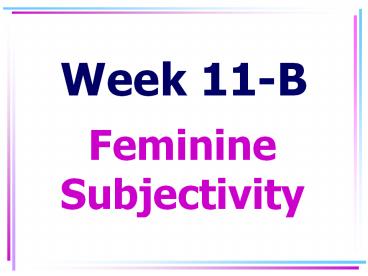Week 11-B - PowerPoint PPT Presentation
Title:
Week 11-B
Description:
An identity must first be in place in order for political interests to be ... denying corporal origins or objectifying the body. Woman as. Subjectivity as ... – PowerPoint PPT presentation
Number of Views:100
Avg rating:3.0/5.0
Title: Week 11-B
1
Week 11-B
- Feminine Subjectivity
2
- I. Butler, Judith.
- II. Braidotti, Rosi.
3
- Butler, Judith. Gender Trouble Feminism and the
Subversion of Identity. Feminist Literary
Theory. 2nd ed. Ed. Mary Eagleton. Oxford, UK
Blackwell, 1996. 367-73.
4
http//www.theory.org.uk/ctr-butl.htm
5
Central Question
- Should feminist politics do without a subject
in the category of women? (367)
6
Foundationalist view
- An identity must first be in place in order for
political interests to be elaborated and,
subsequently, political action to be taken. (367)
7
Problem
- Identity ? I ? to be intelligible
- ? subject to binary opposition
- ? pitted against an Other
- ? generated and restricted by rules . . . of
gender hierarchy and compulsory heterosexuality - ? via signification, which is a regulated
process of repetition - ? gender difference reinforced and fixed (369)
8
- The internal paradox of this foundationalism is
that it presumes, fixes, and constrains the very
subjects that it hopes to represent and
liberate. (372-73)
9
Butlers Argument
- There need not be a doer behind the deed the
doer is variably constructed in and through the
deed. (367)
10
- As the effects of a subtle and politically
enforced performativity, gender is an act, as
it were, that is open to splittings, self-parody,
self-criticism, and those hyperbolic exhibitions
of the natural that, in their very
exaggeration, reveal its fundamentally
phantasmatic status. (371)
11
- The critical task is, rather, to locate
strategies of subversive repetition enabled by
those constructions, to affirm the local
possibilities of intervention through
participating in precisely those practices of
repetition that constitute identity and,
therefore, present the immanent possibility of
contesting them. (371)
12
- Butler argues that rather than being a fixed
attribute in a person, gender should be seen as a
fluid variable which shifts and changes in
different contexts and at different times. - http//www.theory.org.uk/ctr-butl.htm
13
- Butler argues that we all put on a gender
performance, whether traditional or not, anyway,
and so it is not a question of whether to do a
gender performance, but what form that
performance will take. - http//www.theory.org.uk/ctr-butl.htm
14
- Butler suggests that certain cultural
configurations of gender have seized a hegemonic
hold (i.e. they have come to seem natural . . .)
but . . . it doesn't have to be that way. . .
.Butler calls for subversive action in the
present 'gender trouble' -- the mobilization,
subversive confusion, and proliferation of
genders -- and therefore identity. - http//www.theory.org.uk/ctr-butl.htm
15
(No Transcript)
16
(No Transcript)
17
(No Transcript)
18
(No Transcript)
19
(No Transcript)
20
(No Transcript)
21
- Braidotti, Rosi. Nomadic Subjects Embodiment
and Sexual Difference in Contemporary Feminist
Theory. Feminist Literary Theory. 2nd ed. Ed.
Mary Eagleton. Oxford, UK Blackwell, 1996.
411-420.
22
- Three phases of feminist nomadism
- Difference between men and women
- Differences among women
- Differences within each woman
23
I. Difference between Men and Women
Subjectivity as Woman as
-Phallogocentric -Universal notion of the subject -coinciding with consciousness -self-regulating -rational agency -entitled to rationality -capable of transcendence -denying corporal origins or objectifying the body -the lack/excess/other-than/subject -devalorized difference -Non consciousness -Uncontrolled -Irrational -In excess of rationality -Confined to immanence -Identified with the bodycorporality that is both exploited and reduced to silence
24
Central Issues
- How to define woman as other than a non-man?
- How to argue both for the loss of the classical
paradigm of subjectivity and for the specificity
of an alternative female subject? (413-14)
25
II. Differences among Women
Women the Other versus Real-life Women
-as institution and representation (See level 1) Critical hiatus between themfeminist subjectivity -positivity of sexual difference as political project --female feminist genealogies, or countermemory -Politics of location and resistance -dissymmetry between the sexes -experience -embodiment -situated knowledges -women-based knowledges -empowerment -multiplicity of differences (race, age, class, etc.) or diversity
26
Central Issues
- How to create, legitimate, and represent a
multiplicity of alternative forms of feminist
subjectivity without falling into relativism?
(415)
27
III. Differences within Each Woman
Each Real-Life Woman or Female Feminist Subject is
-a multiplicity in herself slit, fractured -a network of Levels of experience (as outlined on levels II and I) -a living memory and embodied genealogy -Not one conscious subject, but also the subject of her unconscious identity as identifications -in an imaginary relationship to variables like class, race, age, sexual choices
28
Central Issue
- How to avoid the repetition of exclusions in the
process of legitimating an alternative feminist
subject? - How to avoid hegemonic recodification of the
female subject? - How to keep an open-ended view of subjectivity,
while asserting the political and theoretical
presence of another view of subjectivity?
(418)
29
- The End































